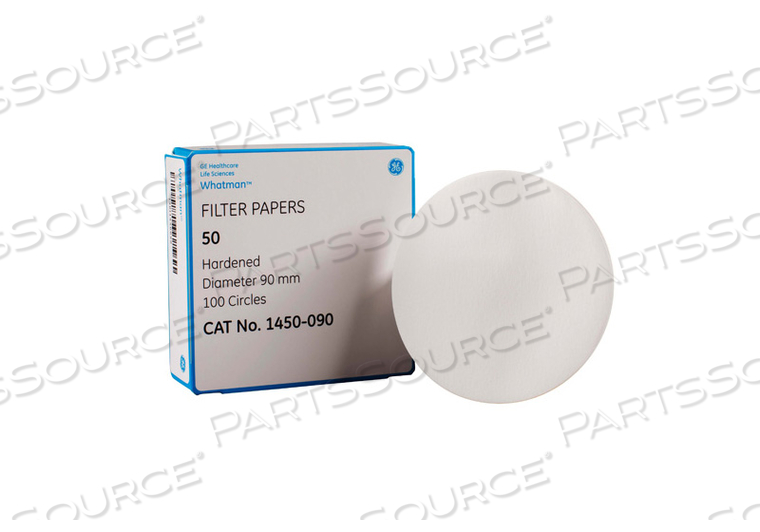PAPER FILTER, 500 MM DIA, GRADE 50 FILTER FOR QUANTITATIVE ANALYSIS, THIN, CIRCLE, 100 PIECES


PAPER FILTER, 500 MM DIA, GRADE 50 FILTER FOR QUANTITATIVE ANALYSIS, THIN, CIRCLE, 100 PIECES
The maximum ash content of these grades is intermediate between ashless and qualitative grades. They are particularly suitable for Buchner filtrations where it is desirable to recover the precipitate from the Filter surface after filtration. Other characteristics include high wet strength and chemical resistance, which are similar to those of the acid-hardened ashless Filter papers. Retention of very fine crystalline precipitates. The thinnest of all Whatman Filter papers. Slow flow rate. Hardened and highly glazed surface. This finish also keeps the paper free from loose surface fibers. Highly suitable for qualitative or quantitative filtrations requiring vacuum assistance on Buchner or three-piece Filter funnels. Very strong when wet. Will withstand wet handling and precipitate removal by scraping. In the electronics industry, the virtual absence of fiber shedding is utilized in carriers for integrated circuits. This grade is also available in Smear Tab format for wipe testing (e.g., testing of surfaces for radionuclide contamination).
The maximum ash content of these grades is intermediate between ashless and qualitative grades. They are particularly suitable for Buchner filtrations where it is desirable to recover the precipitate from the Filter surface after filtration. Other characteristics include high wet strength and chemical resistance, which are similar to those of the acid-hardened ashless Filter papers. Retention of very fine crystalline precipitates. The thinnest of all Whatman Filter papers. Slow flow rate. Hardened and highly glazed surface. This finish also keeps the paper free from loose surface fibers. Highly suitable for qualitative or quantitative filtrations requiring vacuum assistance on Buchner or three-piece Filter funnels. Very strong when wet. Will withstand wet handling and precipitate removal by scraping. In the electronics industry, the virtual absence of fiber shedding is utilized in carriers for integrated circuits. This grade is also available in Smear Tab format for wipe testing (e.g., testing of surfaces for radionuclide contamination).
The maximum ash content of these grades is intermediate between ashless and qualitative grades. They are particularly suitable for Buchner filtrations where it is desirable to recover the precipitate from the Filter surface after filtration. Other characteristics include high wet strength and chemical resistance, which are similar to those of the acid-hardened ashless Filter papers. Retention of very fine crystalline precipitates. The thinnest of all Whatman Filter papers. Slow flow rate. Hardened and highly glazed surface. This finish also keeps the paper free from loose surface fibers. Highly suitable for qualitative or quantitative filtrations requiring vacuum assistance on Buchner or three-piece Filter funnels. Very strong when wet. Will withstand wet handling and precipitate removal by scraping. In the electronics industry, the virtual absence of fiber shedding is utilized in carriers for integrated circuits. This grade is also available in Smear Tab format for wipe testing (e.g., testing of surfaces for radionuclide contamination).
The maximum ash content of these grades is intermediate between ashless and qualitative grades. They are particularly suitable for Buchner filtrations where it is desirable to recover the precipitate from the Filter surface after filtration. Other characteristics include high wet strength and chemical resistance, which are similar to those of the acid-hardened ashless Filter papers. Retention of very fine crystalline precipitates. The thinnest of all Whatman Filter papers. Slow flow rate. Hardened and highly glazed surface. This finish also keeps the paper free from loose surface fibers. Highly suitable for qualitative or quantitative filtrations requiring vacuum assistance on Buchner or three-piece Filter funnels. Very strong when wet. Will withstand wet handling and precipitate removal by scraping. In the electronics industry, the virtual absence of fiber shedding is utilized in carriers for integrated circuits. This grade is also available in Smear Tab format for wipe testing (e.g., testing of surfaces for radionuclide contamination).
The maximum ash content of these grades is intermediate between ashless and qualitative grades. They are particularly suitable for Buchner filtrations where it is desirable to recover the precipitate from the Filter surface after filtration. Other characteristics include high wet strength and chemical resistance, which are similar to those of the acid-hardened ashless Filter papers. Retention of very fine crystalline precipitates. The thinnest of all Whatman Filter papers. Slow flow rate. Hardened and highly glazed surface. This finish also keeps the paper free from loose surface fibers. Highly suitable for qualitative or quantitative filtrations requiring vacuum assistance on Buchner or three-piece Filter funnels. Very strong when wet. Will withstand wet handling and precipitate removal by scraping. In the electronics industry, the virtual absence of fiber shedding is utilized in carriers for integrated circuits. This grade is also available in Smear Tab format for wipe testing (e.g., testing of surfaces for radionuclide contamination).
The maximum ash content of these grades is intermediate between ashless and qualitative grades. They are particularly suitable for Buchner filtrations where it is desirable to recover the precipitate from the Filter surface after filtration. Other characteristics include high wet strength and chemical resistance, which are similar to those of the acid-hardened ashless Filter papers. Retention of very fine crystalline precipitates. The thinnest of all Whatman Filter papers. Slow flow rate. Hardened and highly glazed surface. This finish also keeps the paper free from loose surface fibers. Highly suitable for qualitative or quantitative filtrations requiring vacuum assistance on Buchner or three-piece Filter funnels. Very strong when wet. Will withstand wet handling and precipitate removal by scraping. In the electronics industry, the virtual absence of fiber shedding is utilized in carriers for integrated circuits. This grade is also available in Smear Tab format for wipe testing (e.g., testing of surfaces for radionuclide contamination).
